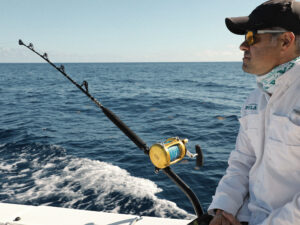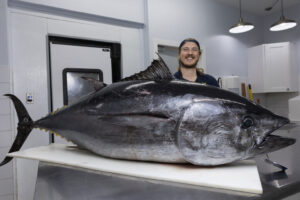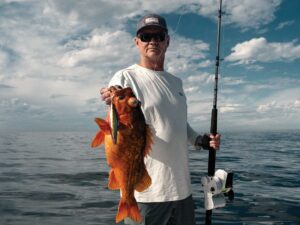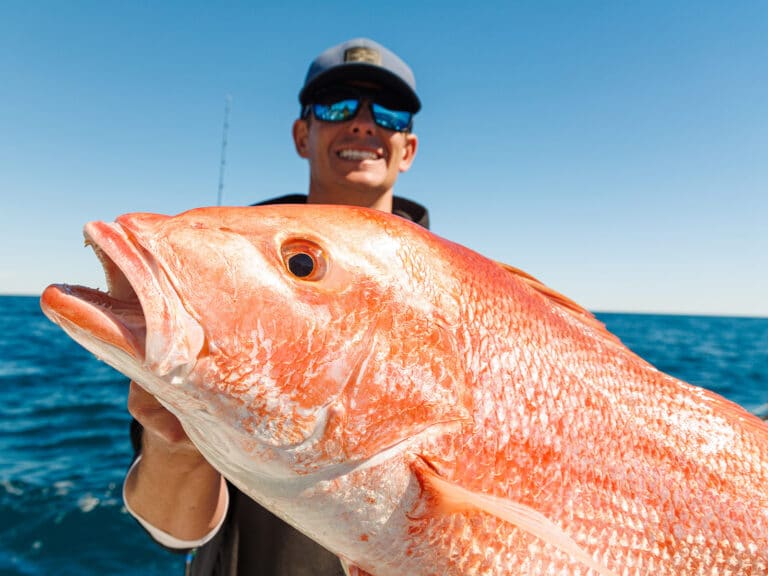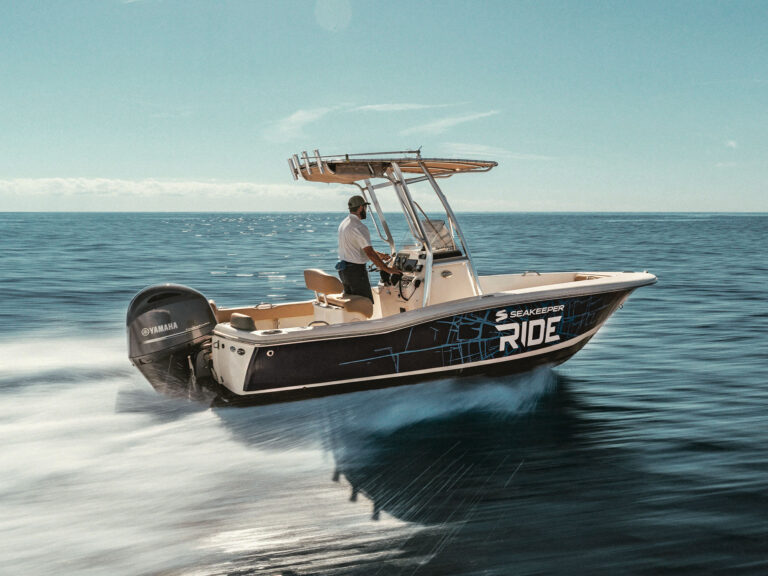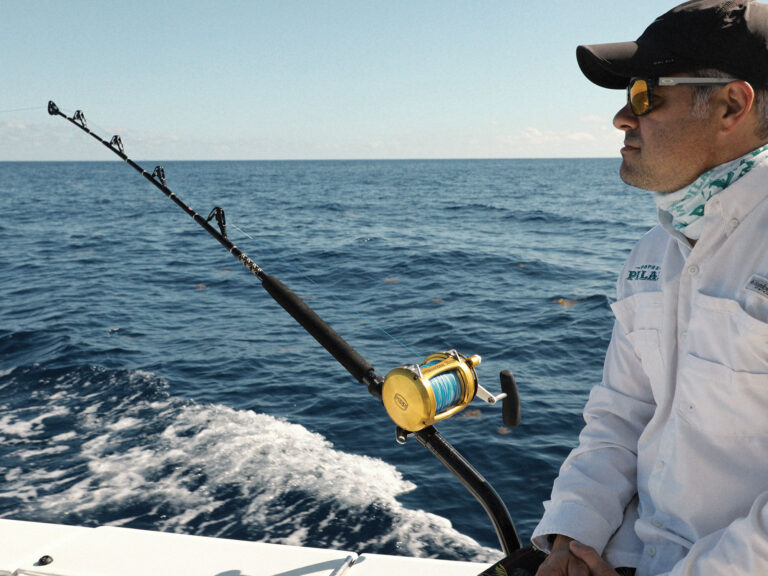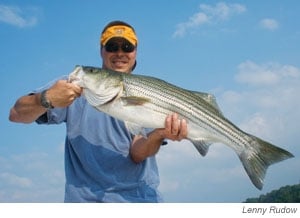
You read it in the fishing reports all the time in Maryland’s Chesapeake country: “Live baits are working well,” or “The stripers are hitting live baits better than cut bait.” Tackle shops that sell live baits of the proper size and type for stripers are few and far between. When the bite centers around livies, you’d better know how to get your own.
Throwing for Gold
Spring and summer are the toughest times to gather live bunker (menhaden), since adults are schooled in relatively deep water. Many anglers rely on spot, which are an excellent striper bait, to fill their livewells, but sharpies who maximize the bite know stripers prefer bunker above all else. Although these fish can dodge the biggest, fastest-sinking cast nets, they’ll never see “bunker snaggers” coming. These are essentially large, weighted treble hooks that you cast beyond a school of bunker and then rip back through it. The downside? Your bait hits the boat already damaged, and four or five out of every dozen are probably going to die before you can get a hook in ’em.
Later in the summer and in fall, when bait is in the shallow waters of creeks and tributaries, a single throw of a cast net is often all that’s required to fill a livewell with frisky peanut bunker in the 3- to 5-inch range. The cast net should be a 6- or 8-footer. The bigger, the better. An 8-footer will allow you to catch five times as much bait in half the time. A 12-foot net with large mesh will sink quickly enough to catch bunker in water as deep as 20 feet.
Peanut bunker are plentiful in virtually all of Chesapeake Bay’s creeks and rivers through the summer and into fall. But many are young-of-the-year and may not reach a good bait size until June or July. You’ll usually have little problem locating bunker until November, when most of the peanuts have left the creeks and rivers to begin their migration to the ocean.
Whenever you cast-net for peanut bunker, your best bet is to launch before sunrise. The trick is to be on the water during darkness, when you can look for lighted piers and bridges. Peanut bunker swarm around the lights, providing the perfect opportunity for you to fill your livewell. Approach lighted waters quietly and slowly, and look for the telltale flips on the surface. One good shot on a school of peanuts will provide you with anywhere from one to six dozen live, kicking baits. Allow at least one-half gallon of circulating raw water for every baitfish, or you’ll experience die-offs. If your well holds only 20 gallons, put in no more than 40 baits.
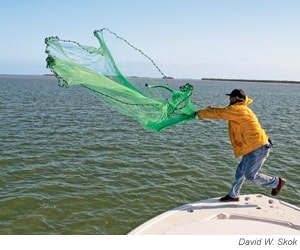
Crack the Nuts
Once your well is full, it’s time to rig up. The rig for live-lining peanuts is as straightforward as it gets: a 4-foot leader of 20- to 40-pound fluorocarbon with a swivel on one end and a 4/0 to 6/0 thin-wire circle hook on the other. Bunker are relatively small, weak fish, and if your hooks are any larger, the baits won’t be able to swim with them. Never hook bunker through the lower jaw and out through the upper. It works well with other live baits, but it doesn’t let the bunker breathe properly. Instead, insert the hook point through the fish’s nose, in through one side and out through the other. This allows it to swim with its mouth open, and bunker will live far longer hooked this way.
One other note: Those who have live-lined spot with guides on the bay may have used a single treble hook behind the spot’s dorsal fin. This rig is more effective at hooking more fish, but it’s also more effective at gut-hooking them. It’s rare to even be able to consider releasing a fish caught with this method; a sport angler will make sure it’s a single circle on the end of his line.
Once you are rigged and ready, set up a menhaden chum line in whatever hot area you normally fish. Put a livie on the bottom and another on the surface. These baits will be hit about twice as often as cut chunks. Watch out for bluefish. They’ll slice peanut bunker in half, and you may go through a dozen baits in half an hour. In this situation, it’s best to try switching locations.

Another way of fishing peanut bunker, especially on windy, rough days in the fall, is to live-line them right in the rivers you caught them from. Stripers in the 14- to 26-inch class will move into the river mouths in the fall to feed on these bunker as they migrate out of the creeks. The timing of the migration changes from year to year, usually beginning in mid- to late September and stretching into November. Look for stripers along channel edges and humps or along shelves in at least 10 feet of water. Drift-fish and stay on the move until you locate a hungry school.
When live-baiting with peanut bunker, it’s often effective to simply toss the bait out there – gentle now, as a big splashdown will sometimes stun these fish – and let it swim weight-free. But sometimes the stripers hug the bottom. You should always run at least one live-line bait without weight, one down near the bottom and one at mid-depth. When you discover the level where the fish are feeding, focus your efforts there.
When live-lining for stripers – whether there’s a bunker or a spot on the end of your line – it’s usually best to leave your reel in free-spool. Reels such as Shimano Baitrunners and Penn Live Liners allow you to set your reel to free-spool so an unsuspecting fish can swim off with a bait. If you don’t own reels with this feature, don’t worry. You can accomplish the same thing by rigging a “hair trigger.” Take a 3- to 4-inch-long twist-tie – the kind that come with garbage bags are good, as are the twisty plastics used to secure toys to their packaging – and wrap it around the base of your rod just above the foregrip. Bend the last inch into a hook shape, and after letting your line out, run it through this hook. The twist-tie will hold your line in place, but as soon as a fish strikes, it will straighten to release the line. When a fish bites, allow it to eat without feeling any resistance on the line. Usually a slow three count allows plenty of time for the fish to get the bait into its mouth. Smart anglers count to five before reeling up tight. And tight is exactly how your lines will be if you have a well full of peanut bunker when the reports say that live baits are the hot ticket to Chesapeake stripers.
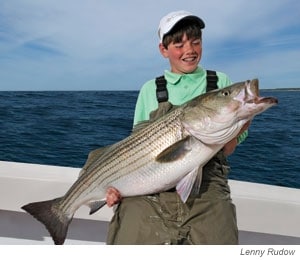
Striper Live-Lining Hot Spots The hottest spots change from season to season, but some areas are perennially reliable. In the upper Chesapeake, such a spot is the mouth of the Magothy River. Most seasons, you’ll find stripers in search of peanut bunker just outside of the river to the north of Podickery and also inside the river near Dobbins Island near the green No. 1 marker, where the bottom drops to 12 or 14 feet. Other upper-bay hot spots for live-lining bunker are the mouth of the Chester River and the Love Point area. Any of the humps south of Rock Hall (commonly called the Entrance Lumps) are a good bet, and the large northernmost underwater section of Love Point, where it drops erratically from 15 to 35 feet, is another place you’ll want to check out.
Middle-bay anglers with a well full of peanuts will want to head for the mouth of the South and West rivers, an extremely productive area where the rivers join just before entering the open Chesapeake. The long contour between the red No. 6 and No. 4 markers in the south is another spot that produces year in and year out.
If you have access to Eastern Bay, check out the drop off the southern edge of Parson’s Island, where the water goes from a couple of feet down to 25 feet. Tilghman Point and the north and west sides of Poplar Island are other hot spots that produce in Eastern Bay most seasons. Slide a little farther south, and the Diamonds, just outside the Choptank River, produce reliable action year after year. But the waters on the north side of the Gas Docks, a liquid-gas unloading facility just north of the Patuxent River, are as close as it comes to a sure bet for live-lining. And the Middle Grounds, just east of Point Lookout and north of the Virginia line, is where southern-bay anglers should give this technique a try.
Upper Chesapeake
Magothy River
Dobbins Island drop-off: 39° 04.807′ N, 76° 27.319′ W
North of Podickery: 39° 02.606′ N, 76° 24.173′ W
Chester River
Entrance Lumps: 39° 04.984′ N, 76° 14.760′ W
Love Point Bump: 39° 03.829′ N, 76° 16.397′ W
Middle Chesapeake
South/West River Mouth: 38° 52.554′ N, 76° 29.135′ W
South River: No. 6 to No. 4 contour: 38° 54.694′ N, 76° 28.836′ W
**Eastern Bay **
Parson’s Island: 38° 53.721′ N, 76° 15.591′ W
Tilghman Point: 38° 51.334′ N, 76° 16.802′ W
Poplar Island north: 38° 47.311′ N, 76° 22.670′ W
Lower-Middle Chesapeake
Choptank River: the Diamonds: 38° 36.956′ N, 76° 20.174′ W
Gas Docks (north of): 38° 25.177′ N, 76° 24.230′ W
Middle Grounds: 38° 01.166′ N, 76° 10.608′ W
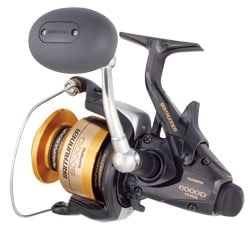
Maryland: Chesapeake Bay Rods: Light- to medium-weight conventional or spinning rods with slow action. Reels: Conventional or spinning in the 12- to 20-pound-class range. Spinning reels should have a free-spool function; try a Shimano Baitrunner or a Penn Live Liner. Line: 12- to 20-pound-test monofilament. Braid does not work well when live-lining bunker because the lack of stretch and increased sensitivity allow the stripers to feel something’s wrong, and they’ll often spit the bait. Baits: Live bunker. Rigs: 4-foot-long 20- to 40-pound fluorocarbon with a snap swivel on one end and a 4/0 to 6/0 thin-wire circle hook on the other. Rigs should be weighted and/or unweighted and fished through varying levels of the water column until a bite pattern is established. What: Striped bass. When: May through June for snagging bunker, with peanuts for cast-netting coming on strong in late summer. The fall peanut bunker migration (late September through November) turns the heat up to maximum. Where: Maryland’s portion of the Chesapeake Bay and its tributaries, ranging from the Chester River to the Potomac River. Who: You. Most guides do not put in the time and effort necessary to catch live bunker but instead fish with spot. If you’d like to give this a shot, you’re on your own.

